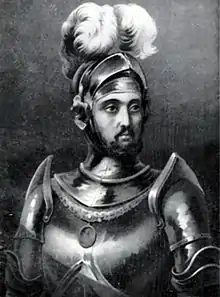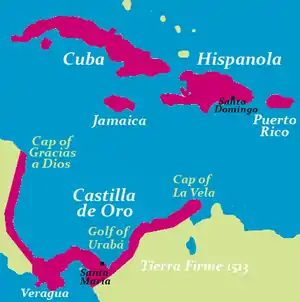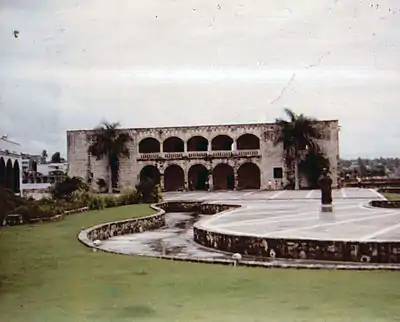Diego Columbus
Diego Columbus (Portuguese: Diogo Colombo; Spanish: Diego Colón; Italian: Diego Colombo; 1479/1480 – February 23, 1526) was a navigator and explorer under the Kings of Castile and Aragón. He served as the 2nd Admiral of the Indies, 2nd Viceroy of the Indies and 4th Governor of the Indies as a vassal to the Kings of Castile and Aragón. He was the elder son of Christopher Columbus and his wife Filipa Moniz Perestrelo.[3]
Diego Columbus | |
|---|---|
 Diego Columbus | |
| 2nd Viceroy of the Indies | |
| In office 1511–1526 | |
| Monarch | Joanna of Castile (1511–1526), Charles I of Spain (1516–1526) |
| Governor | himself |
| Preceded by | Christopher Columbus |
| Succeeded by | Antonio de Mendoza (as Viceroy of New Spain) |
| 2nd Admiral of the Indies | |
| In office 1506–1526 | |
| Monarch | Joanna of Castile (1506-1526), Philip I of Castile (1506), Charles I of Spain (1516-1526) |
| Preceded by | Christopher Columbus |
| Succeeded by | Luis Colón de Toledo |
| 4th Governor of the Indies | |
| In office 1509–1518 | |
| Appointed by | Ferdinand II of Aragon, as regent to Joanna of Castile (1508) |
| Preceded by | Nicolás de Ovando y Cáceres |
| Succeeded by | Diego Velázquez de Cuéllar |
| 1st Duke of Veragua, 1st Marquess of Jamaica | |
| In office 1509–1526 | |
| Appointed by | Ferdinand II of Aragon, as regent to Joanna of Castile (1508) |
| Succeeded by | Luis Colón de Toledo |
| Personal details | |
| Born | 1479/1480 Portugal |
| Died | February 23, 1526 (aged 45) La Puebla de Montalbán, Spain |
| Spouse(s) | María de Toledo y Rojas |
| Children | 5, including Luis |
| Parents | Christopher Columbus Filipa Moniz Perestrelo |
| Residence | Viceregal Palace of Columbus |
| Occupation | Navigator Explorer |
He was born in Portugal, either in Porto Santo in 1479/1480, or in Lisbon in 1474. He spent most of his adult life trying to regain the titles and privileges granted to his father for his explorations and then denied him in 1500. He was greatly aided in this goal by his marriage to María de Toledo y Rojas, niece of the 2nd Duke of Alba, who was the cousin of King Ferdinand.
Life

Diego was made a page at the Spanish court in 1492, the year his father embarked on his first voyage. Diego had a younger half-brother, Fernando, by Beatriz Enríquez de Arana.
Ferdinand and Diego had been pages to Prince Don Juan, then became pages to Queen Isabella in 1497.[4]

In August 1508, he was named Governor of the Indies, the post his father had held, arriving to Santo Domingo in July 1509. He established his home (Alcázar de Colón), which still stands there, in Santo Domingo in what is now the Dominican Republic.
According to Floyd, Diego "...was accompanied by a splendid entourage: his wife, Doña Maria, the first gran dama of the New World, the Duke of Alba's niece, with her own suite of doncellas; and his immediate relatives - Fernando his half-brother, his two uncles, Diego and Bartolomé, and his cousins, Andrea and Giovanni. Also on the expedition were his criados and his father's old retainers: Marcos de Aguilar, his forthright alcalde mayor, Diego Mendez, his business manager, and Gerónimo de Agüero, his former tutor. Other loyal Colombistas met him at Santo Domingo - his uncle by marriage, Francisco de Garay, whom he named alguacil mayor, and Bartolomé's criados, Miguel Díaz, Diego Velázquez, and Juan Cerón. His coming represented the permanent establishment of the most titled and notable family in the islands, at least for many years."[2]:137
In 1511, a royal council declared Hispaniola, Puerto Rico, Jamaica and Cuba were under Diego's power "by right of his father's discovery." However, Uraba and Veragua were deemed excluded, since the council regarded them as being discovered by Rodrigo de Bastidas. The council further confirmed Diego's titles of Viceroy and admiral were hereditary, though honorific. Furthermore, Diego had the right to one-tenth of the net royal income. However, factions soon formed between those loyal to Diego and Ferdinand's royal officials. Matters deteriorated to the point that Ferdinand recalled Diego in 1514. Diego then spent the next five years in Spain "futilely pressing his claims." Finally, in 1520, Diego's powers were restored by Charles.[2]:143–144,148,197
Diego returned to Santo Domingo on 12 Nov. 1520 in the midst of a native revolt in the area of the Franciscan missions on the Cumana River. This was also the area of the Spanish salt and pearl trade, besides slave hunting. Diego sent Gonzalo de Ocampo on a punitive expedition with 200 men and 6 ships. Then in 1521, Diego invested in Bartolomé de las Casas' enterprise to settle the Cumana area. That failure, blamed on Diego, meant the loss of the king's confidence. That loss, plus Diego's defiance of royal power on Cuba, forced Charles to reprimand Diego in 1523 and recall him back to Spain.[2]:204–210,213,215
After his death, a compromise was reached in 1536 in which his son, Luis Colón de Toledo, was named Admiral of the Indies and renounced all other rights for a perpetual annuity of 10,000 ducats, the island of Jamaica as a fief, an estate of 25 square leagues on the Isthmus of Panama, then called Veragua, and the titles of Duke of Veragua and Marquess of Jamaica.
The first major slave revolt in the Americas occurred in Santo Domingo during 1522, when enslaved Muslims of the Wolof nation led an uprising in the sugar plantation of admiral Don Diego Colon. Many of these insurgents managed to escape to the mountains where they formed independent maroon communities among the Tainos.
After Columbus's death on February 23, 1526, in Spain, the rents, offices and titles in the New World went into dispute by his descendants.
Marriage and children
He initially planned to marry Mencia de Guzman, daughter of the Duke of Medina Sidonia.,[5] but he was forced by King Fernando to marry the king's cousin María de Toledo y Rojas (c. 1490 – May 11, 1549), who secured the transportation and burial of her father-in-law, Christopher Columbus, in Santo Domingo. She was the daughter of Fernando Alvarez de Toledo, 1st Lord of Villoria, son of García Álvarez de Toledo, 1st Duke of Alba, and his first wife María de Rojas, and had the following children:[6]
- María Colón de Toledo (c. 1510 –), married to Sancho Folch de Cardona, 1st Marquess of Guadalest
- Luis Colón, 1st Duke of Veragua
- Cristóbal Colón de Toledo (c. 1510 – 1571), married firstly to María Leonor Lerma de Zuazo, without issue; married secondly to Ana de Pravia, and had one son (Diego Colon y Pravia [c. 1551 - Jan 27, 1578]) and one daughter (Francisca Colon y Pravia, [c. 1552 - April 1616]; and married thirdly to María Magadalena de Guzmán y Anaya, and had:
- Diego Colón de Toledo, father of Diego the 4th Admiral of the Indies.
- Francisca Colón de Toledo y Pravia (c. 1550 – April, 1616), married Diego de Ortegón (c. 1550 –), and had four children: Guiomar de Ortegon y Colon [d. 1621]; Jacoba de Oretgon y Colon [d. 1618]; Ana de Ortegon y Colon; and Josefa de Ortegon y Colon[7]
- María Colón de Toledo y Guzmán (c. 1550 –), married to Luis de Avila, and had:
- Cristóbal de Avila y Colón (1579 –), unmarried and without issue
- Luis de Avila y Colón (1582-1633), married Maria de Rojas-Guzman Grajeda, without issue; married secondly to Francisca de Sandoval and had one son Cristobal
- Juan Colón Dávila (-1622), married Leonor Luyando y Manuel and had three sons.
- Bernardino Dávila y Colón (-1633)
- Maria de Avila y Colón (1592-), married Alonso de Guzman Grajeda and had one daughter (Mayor de Grajeda y Avila [c.1611-])
- Magdalena Dávila Colón (1592-1621)
- María Dávila Colón (1596-)
- Juana Colón de Toledo (died c. 1592), married her cousin Luis de La Cueva y Toledo; their only child was María Colón de la Cueva (c. 1548-c.1600) who claimed the duchy of Veragua and died in New Spain (México).[8]
- Isabel Colón de Toledo (c. 1515 –), married Dom Jorge Alberto de Portugal y Melo (1470 –), 1st Count of Gelves (who married secondly; his 1st marriage to Dona Guiomar de Ataíde remained childless), son of Dom Álvaro de Bragança, Lord of Tentúgal, Póvoa, Buarcos and Cadaval and Chancellor-Major of the Realm of Portugal. Their grandson, D. Nuno Alvares Pereira Colón y Portugal, Duke of Veragua and Admiral of the Indies became regent of the Kingdom of Portugal from 1621 until his death.
References
- Gilman, D. C.; Peck, H. T.; Colby, F. M., eds. (1905). . New International Encyclopedia (1st ed.). New York: Dodd, Mead.
- Floyd, Troy (1973). The Columbus Dynasty in the Caribbean, 1492-1526. Albuquerque: University of New Mexico Press. p. 31.
- "Diego Columbus". Encyclopedia Britannica.
- Columbus, Ferdinand (1959). The Life of the Admiral Christopher Columbus by his son Ferdinand. New Brunswick: Rutgers, The State University. p. 175.
- Miles H. Davidson (1997). Columbus Then and Now: A Life Reexamined. University of Oklahoma Press. p. 49. ISBN 9780806129341.
- "GeneAll.net - Diego Colón, 1. duque de Veragua".
- Inclan, John D. "The Descendants of Christopher Columbus, Admiral of the Ocean Seas".
- Winsor, Justin (1891), Christopher Columbus and how He Received and Imparted the Spirit of Discovery, Chadwyck-Healey Ltd., pp. 526–527
External links
- . New International Encyclopedia. 1905.
| Government offices | ||
|---|---|---|
| Preceded by Nicolás de Ovando |
Governor of the Indies 1509–1511 |
Succeeded by Diego Velázquez de Cuéllar |
| Military offices | ||
| Preceded by Christopher Columbus |
Admiral of the Indies 1508–1526 |
Succeeded by Luis Colón de Toledo |
| Regnal titles | ||
| In abeyance Title last held by Christopher Columbus |
Viceroy of the Indies 1511–1526 |
Extinct |
| Spanish nobility | ||
| New title | Duke of Veragua 1509–1526 |
Succeeded by Luis Colón de Toledo |
| Marquis of Jamaica 1509–1526 | ||